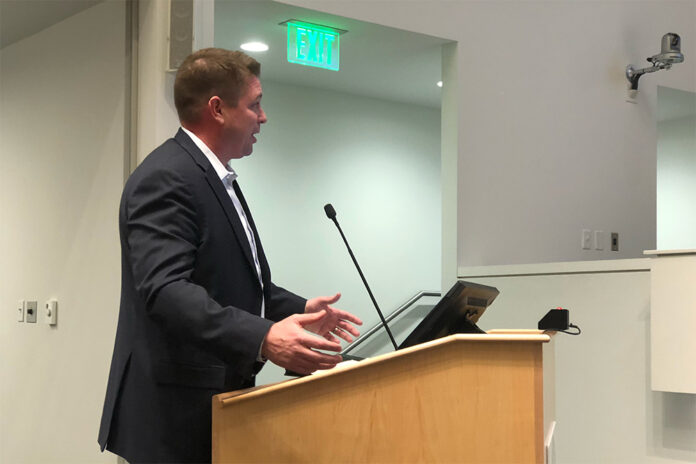
[quote_box_right]“The Pinal County water management system is broken. It’s been broken for two-and-a-half years.” — Ron Fleming, Global Water[/quote_box_right]Global Water Resources CEO Ron Fleming said the lack and expense of water will someday seriously limit growth in Arizona.
He said the water issue is already hindering growth in some parts of Pinal County.
In speaking before the Maricopa City Council on Tuesday during a work session, Fleming said he doesn’t see the water situation as a crisis because outside water can be purchased if local reserves aren’t enough. He did admit that buying water will be expensive.
“Water, it’s a very complicated topic right now. There’s a lot of moving parts,” Fleming said. “It is important to know that smart water management that we have put into place in this city is more than adequate right now.”

He said smart meters and reuse of recycle water is vital to Pinal County’s future.
“The Pinal County water management system is broken. It’s been broken for two-and-a-half years,” Fleming said. “It’s been a year since the Department of Water Resources has met the stakeholders and talked about how we work together to fix that broken water supply program.”
He said the good news is that the City of Maricopa has wells, and growth can occur.
However, in other parts of the county the lack of quality water is already impacting growth opportunities, but he didn’t say what areas are impacted.
Arizona has launched a Drought Contingency Proposal (DCP) program with the federal government. Fleming said the DCP will likely result in more underground pumping in Pinal County as less water will be taken out of the Colorado River.
“Groundwater is the foundation for growth in Pinal County for the foreseeable future,” Fleming said. “What we need to do is truly understand the groundwater aquifers in the county, so that we can properly establish that foundation that the state can build from. We need to try and determine what adaptation and mitigation strategies are necessary to address a longer-term issue.”
He said Global Water is using the state’s water model as a guide, but the company wants to use it in different ways to possibly find better solutions.
“People are surprised to learn that there isn’t a regional water plan. It is up to the independent city,” he said, adding the state does regulate water but they don’t necessarily solve issues that arise.
He said it makes sense that cities in this area work together to make a more regional resource plan.
Jake Lenderking, Global Water’s director of water resources, told the city council water resources are adequate currently in Maricopa. He went through a PowerPoint presentation showing water demand and expectations for the future.
He said the annual water that flows into the Colorado River system is being directly impacted by the drought that has been going on for decades.
The shortages mean less water is available for everything including cities and agriculture.
“The good news is … we’re in a good place,” Fleming said after the presentation. “We won’t see any of these issues. The issue is long-term. The things we talked about here today could prevent growth at some point. Economic development, job loss, tax revenues. When we step out from the city of Maricopa, that situation is already occurring in some parts of Pinal County.”
He said the state of Arizona is trying to ensure “we get the maximum benefit of the water resources that we have available.”
He said this also impacts the cost of water and makes it rise “fairly rapid.”
“What DCP is about is protecting the Colorado River and Lake Mead,” he said.
Fleming said once Lake Mead hits the maximum drought line, there are “immediate mandatory restrictions” put into place on the state’s ability to take water is seriously impacted. The DCP is to help prevent Lake Mead from hitting the drought line, so deep restrictions don’t occur.
Pinal County Board of Supervisors approved a resolution Jan. 9 to urge the state Legislature “to provide sufficient funds to Pinal Agricultural Enterprises to access the groundwater necessary to allow the Pinal County agricultural economy to continue when Colorado River water is limited.”
“I don’t believe that we are going to get to a place in the local community or in the greater state where it significantly inhibits our ability to grow and do business,” Fleming said. “It’s just going to cost more, take longer and get more complicated, but we will solve this.”
He said the cheapest water resource available is “what we have today.” He said everyone needs to protect, stretch, conserve and get maximum benefit from current supply before “we have to go after other resources.”
He added, “But that day will come … It won’t limit the growth here, but we need to know that it will come with additional costs. The resources are out there. It will just cost more and take more time to put it into place when that day comes.”
City councilman Marvin Brown has been concerned about water for decades. He questioned Fleming’s optimism about the future of water in Arizona. Many, including Brown, believe the state’s water resources will be in serious shape by 2026.
“2026 will happen,” Brown said.
Fleming said that the future of water is not a crisis yet, but it is also not “rosy.” He said the solution is “to import water from somewhere else.”
“We are blessed in Pinal County with very large high quality underground aquifers. The situation that has developed is through the state’s ensured water supply program, which is based on a regulatory construct and their projections of huge demand in this area,” Fleming said, adding that 95 percent of water pumping is for agriculture.
He said he believes, in the future, ag producers will likely have to give up some of their water resources.
“There is a lot of opportunity to do more with the resources that we are blessed with here. I think Pinal County can handle a significant amount of growth,” he said.
Fleming told the city council Global Water’s board of directors just approved $8 million for infrastructure improvements in Maricopa. He said the funds will be used for well, distribution and pipeline improvements.
“What we’re going to focus on primarily are pipeline projects,” Fleming said. “We need to do some new pipeline extensions that further connect our distribution grid.”
He said it will make pressure and flow much better across their pipeline system, especially with the growth of Maricopa and across the farther reaches of this network.
He said the expansion of the Copper Sky area will mean more water will be needed in the city as housing for 3,000 additional residents will be added. Global Water will also be fixing some of the older parts of their pipeline system.
Another project on the table is Global Water’s first aquifer recharge facility.
“We will be taking the excess recycled water and recharging it into the underground aquifer,” he said, adding this is the second recharge facility in Pinal County.
The facility will eliminate all present water discharge into the Santa Rosa Wash.
“We reused the recycled water for all outdoor common area irrigation,” he said. “However, in winter months, there is more supply than there is demand.”






![City gave new manager big low-interest home loan City Manager Ben Bitter speaks during a Chamber of Commerce event at Global Water Resources on April 11, 2024. Bitter discussed the current state of economic development in Maricopa, as well as hinting at lowering property tax rates again. [Monica D. Spencer]](https://www.inmaricopa.com/wp-content/uploads/2024/04/spencer-041124-ben-bitter-chamber-property-taxes-web-218x150.jpg)

![3 things to know about the new city budget Vice Mayor Amber Liermann and Councilmember Eric Goettl review parts of the city's 2024 operational budget with Mayor Nancy Smith on April 24, 2024. [Monica D. Spencer]](https://www.inmaricopa.com/wp-content/uploads/2024/04/spencer-042424-preliminary-budget-meeting-web-218x150.jpg)


![Alleged car thief released without charges Phoenix police stop a stolen vehicle on April 20, 2024. [Facebook]](https://www.inmaricopa.com/wp-content/uploads/2024/04/IMG_5040-218x150.jpg)





